Recent Articles
Popular Makes
Body Types
2020 Toyota Supra Road Test and Review
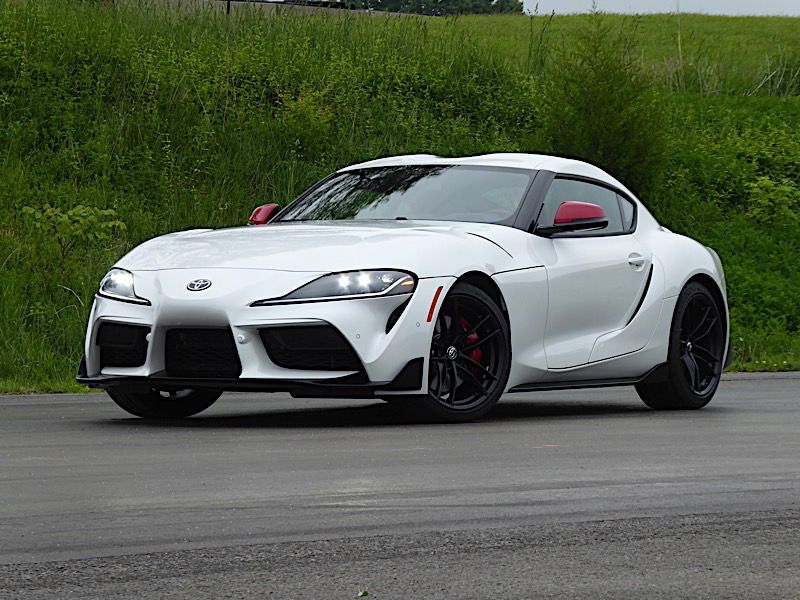
20 supra front abt sessions ・ Photo by Ron Sessions
After disappearing from Toyota showrooms for more than 20 years, the brand’s iconic Supra returns as a 2020 model. An all-new fifth-generation version of Toyota’s iconic two-seat sports car goes on sale this July. Toyota is looking to the low-slung, expressively designed rear-drive Supra to add a little spice to its lineup. It’s no coincidence that the production version of the Supra arrives in the U.S. just in time to become the face of Toyota’s NASCAR Infinity effort in the U.S.
The new Supra shares its engine, drivetrain, and basic platform with the also-new BMW Z4 roadster. The two sports cars will be assembled by master contract car builder Magna-Steyr in Graz, Austria. Officially, Toyota’s fastback coupe is called the Gazoo Racing Supra or GR Supra, but few new car buyers in the U.S. are likely familiar with the Gazoo (pronounced like WA-zoo, not Ka-ZOO) name. Including the $930 destination charge, Toyota is pricing the base Supra 3.0 at $50,920, the 3.0 Premium at $54,920, and (for the first 1,500 units sold in the U.S. only) the Launch Edition at $56,180.
Shape Shifter
The new Supra draws many of its design cues — such as its prominent snorkel-like center grille, long hood, and side scallops to the big liftgate spoiler — from the fourth-generation model sold from 1993 to 1998. Toyota also tapped the limited-production Yamaha-built 2000 GT of 1967 for the distinctive double bubble roof. The angular and distinctly non-retro Toyota FT-1 concept, which made a big splash in 2014, also contributed to the design. Modern touches include all-LED exterior lighting, and the new Supra will also be the first Toyota to wear matte-finish paint.
With an eye cast to challenging the Porsche Cayman and Boxster, Toyota worked to create a sports car with a short wheelbase for quick turn-in and wide stance for maximum grip. Dimensionally, the new Supra measures within a fraction of an inch of the wheelbase and length of the two Porsches. The 2020 Supra’s 97.2-inch wheelbase is 3.2 inches shorter than the last-generation Supra’s or the current Nissan 370Z. Wider at the back than the front, the new Supra has a wider front and rear track than the 370Z. Aluminum doors and hood and a composite liftgate help shave the 2020 Supra’s weight.
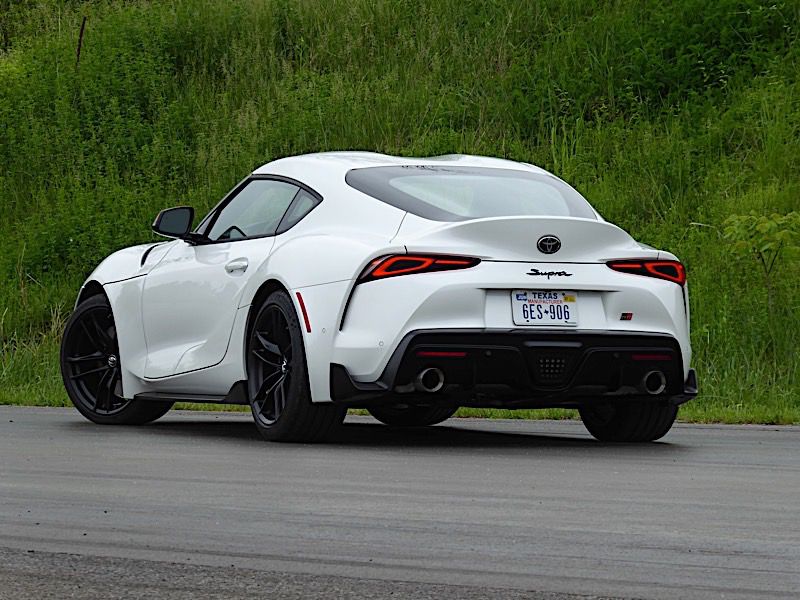
Photo by Ron Sessions
Straight Six Turbo
One of the big draws of earlier Supra models was their smooth and torquey inline six-cylinder engine. Toyota no longer makes an inline six, but BMW does — another reason the Japanese automaker sought the partnership for this project. Although 2020 Supras will be available in some countries with a four-cylinder turbo also of BMW origin, all U.S.-bound models will come with a 335-horsepower 3.0-liter BMW DOHC inline-six with a twin-scroll turbocharger and variable valve timing and lift.
This is the same six-cylinder that powers versions of the current BMW 5 Series, 7 Series, and X5 — and in the 3,397-pound two-seat Supra, it delivers an ample 10:1 weight-to-power ratio. That is sufficient to enable the 2020 Supra to hustle from zero to 60 mph in 4.1 seconds, which gives it the distinction of being the quickest production Toyota ever. The dual-scroll turbo spins up quickly with no lag, delivering crisp and satisfying throttle response. And it sounds great in the process, aided by a dual-mode exhaust that routes exhaust gases through less-baffled pipes when Sport mode is selected. Equally enticing are the crackles and pops barking from the pipes when decelerating from speed or lifting the throttle.
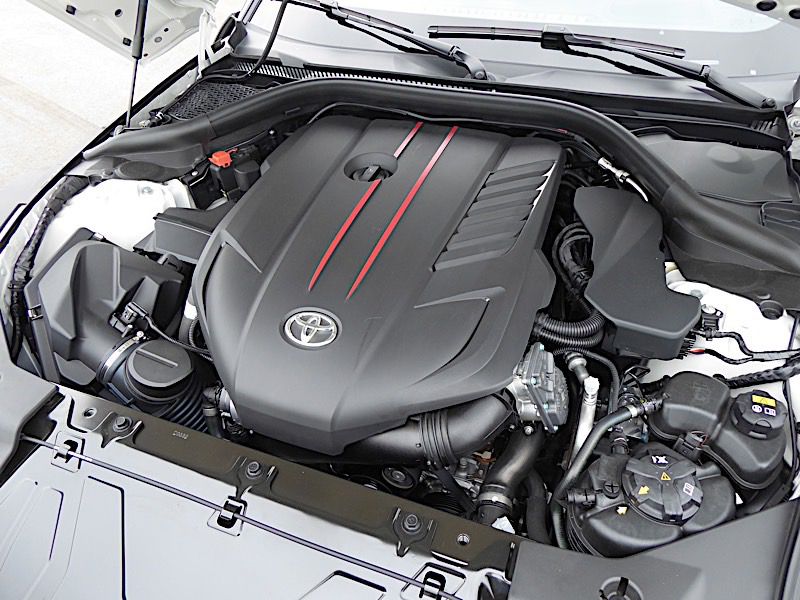
Photo by Ron Sessions
Gearing Up
Stick-shift fans take note: A ZF 8HP eight-speed automatic shared with the BMW Z4 is the only transmission available. Not to worry, though, as the eight-speed automatic delivers seamless, lightning-quick shifts for pleasing response over a broad range of driving situations. The electronic shifter (shared with the Z4) falls neatly into hand. A manual shift gate on the console and paddle shifters on the steering wheel give manual control when desired. Selecting Sport Mode on the console-mounted switch will put the car in the right sequence of gears for spirited driving without you having to sweat it out mid-corner. Driving modes also affect damping rates, steering effort, throttle response, and transmission shift mapping.
Launch control enables aircraft-carrier catapult-like acceleration; with the car stopped in Drive, select launch control, step firmly on the footbrake, matt the gas pedal and a few Mississippis later release the brake and enjoy the ride. The Supra achieves EPA fuel economy ratings of 24 mpg in the city, 31 mpg on the highway, and 26 mpg combined.
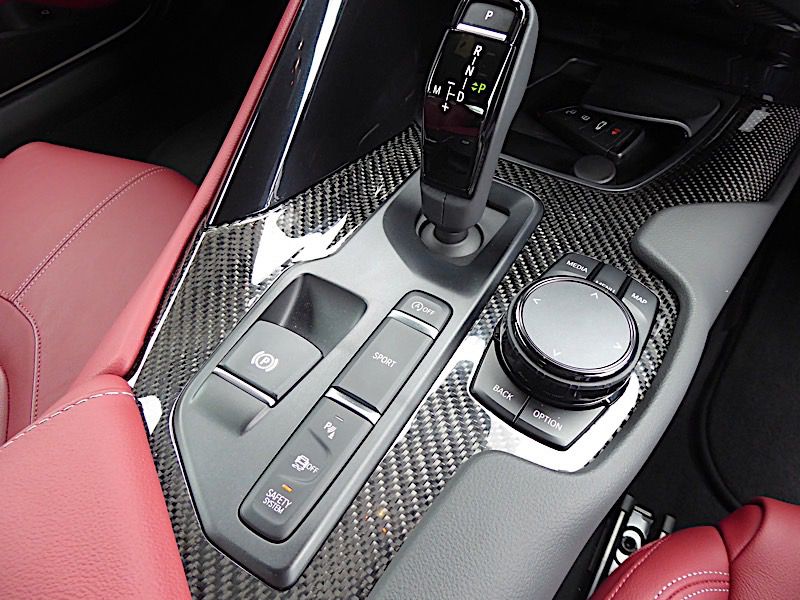
Photo by Ron Sessions
Driver-Oriented Controls
Arrayed in front of the driver is an easy-to-read single-meter driver display with digital speed readout and a large, sweeping tachometer. The instrument panel features an uncluttered, sweeping horizontal design and has a low profile to aid forward visibility. The center console is trimmed with real carbon fiber and features padded sides for knee comfort during hard cornering. Note, however, aside from a pair of cupholders, a small covered bin at the rear, and a phone-sized open shelf (which includes a wireless charger in premium trims) under the dash, there isn’t a lot of storage for small items in the console.
Standard comfort and convenience items include a small-diameter leather-wrapped steering wheel with remote audio controls, dual-zone automatic climate control, keyless smart entry, push-button start, a garage-door opener, rain-sensing wipers, auto-dimming rearview mirrors, power door locks and outside mirrors, and auto up/down power side windows. Basic cruise control is standard with adaptive all-speed cruise control available in a $1,195 optional driver-assist package. A color head-up display for driving and navigation information is also on the options list.
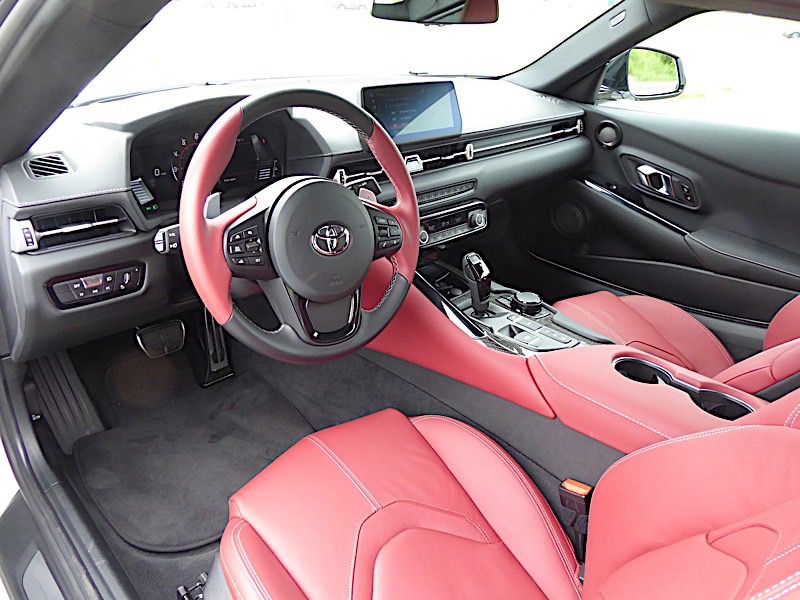
Photo by Ron Sessions
Supra Seating
The Supra’s fabulous-looking sport-contoured seats are 14-way power-operated and include four-way lumbar settings. An adjustable backrest feature lets you tighten the side bolsters for spirited performance driving and relax them for everyday comfort or long-distance drives. The standard seat coverings are black leather and faux suede in the base Supra 3.0, with full leather standard in higher trims. The rich-looking red leather interior seen here is available only in the Supra Launch Edition.
While cozy inside, the Supra’s cabin offers decent space for the driver and passenger. Despite the low, sloping roof, headroom is more than adequate courtesy of the double-bubble roof design. No sunroof is available.
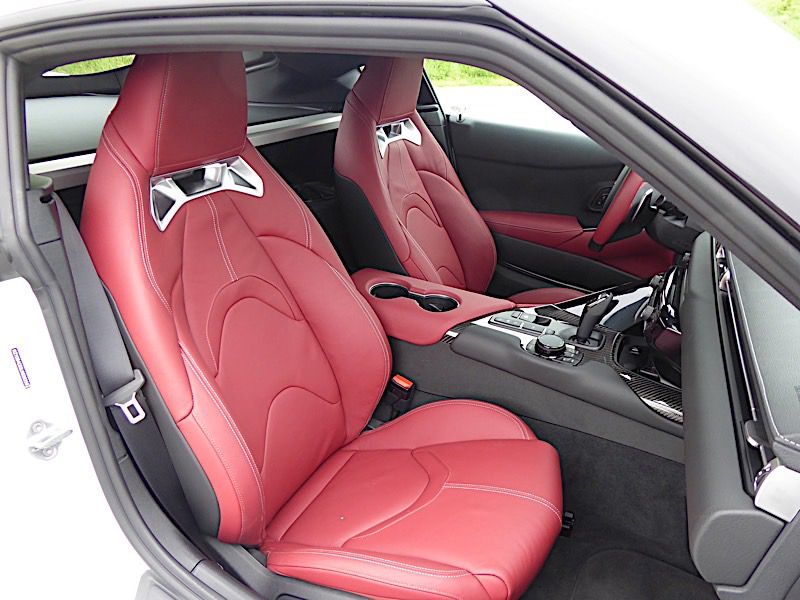
Photo by Ron Sessions
YouDrive
Toyota and Lexus products have used a variety of infotainment controllers, ranging from touchpads to mouse-like devices in recent years. The Supra’s setup, however, comes straight from BMW with this familiar iDrive control wheel on the console. As with BMWs, the Supra’s system can also be controlled with the touchscreen icons, steering wheel controls, and a hard analog volume button and other shortcut buttons on the dash.
The base Supra 3.0 comes standard with a 6.5-inch infotainment display, a 10-speaker, 205-watt AM/FM radio, SiriusXM, iPod-ready USB 2.0 port, and Bluetooth wireless music streaming and hands-free phone capability. The 3.0 Premium and the Launch Edition upgrade to an 8.8-inch center display. They also include embedded navigation, a rich-sounding 12-speaker, 500-watt JBL surround sound system, Supra Connect telematics services for your cellphone, wireless charging for Qi-enabled devices, and a color head-up display. A first for Toyota, the Supra Premium and Launch Edition also gain wireless Apple CarPlay connectivity for cellphone mirroring — but no Android Auto.
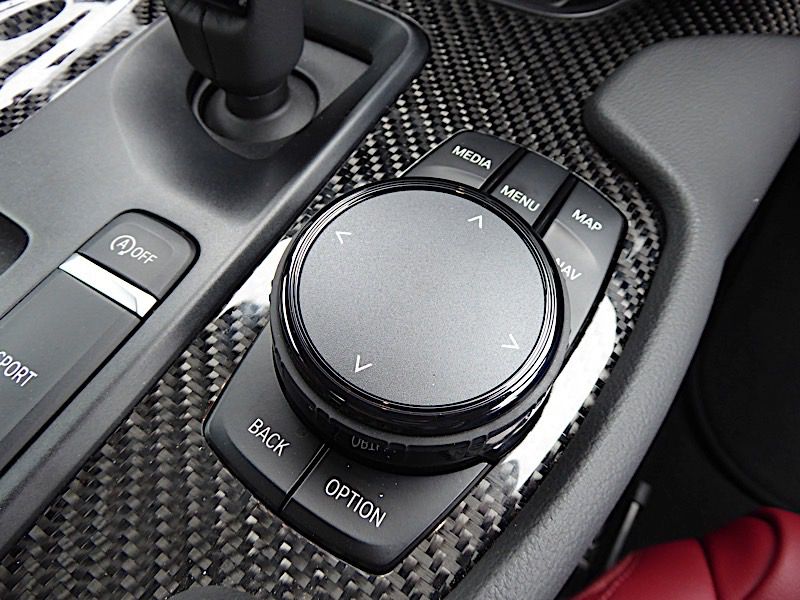
Photo by Ron Sessions
Under the Hatch
With the new Supra’s compact overall proportions and sleek fastback shape, you wouldn’t expect much room for luggage in the cargo bay. A minivan, the Supra isn’t.
But even though much of the space between the rear wheels is taken up with suspension hardware, structural cross-bracing, and some of the audio system’s speakers, there’s a reasonably accommodating 10.2 cubic feet of cargo space under the rear hatch. Longer items won’t fit, and a pair of golf bags are definitely out of the question. However, pack smartly and you can stash several roller bags and a smaller computer bag or two back there for a weekend vacation. That's something you can’t do in a Mazda MX-5 Miata.
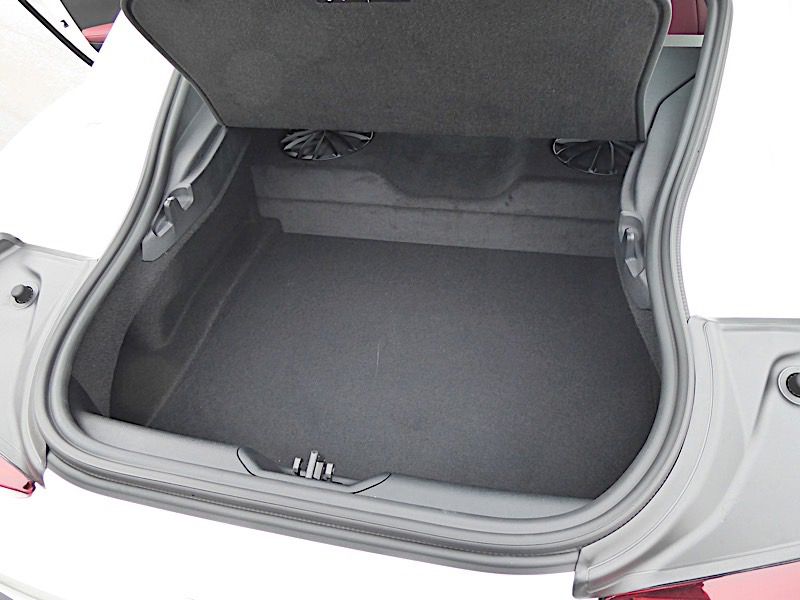
Photo by Ron Sessions
Safety First
The Supra’s standard suite of safety features includes eight airbags, a backup camera, a forward collision warning, automatic emergency braking with pedestrian detection, a lane-departure warning with steering assist, and automatic high beams. You can also selectively choose which systems you want to use.
Optional on all models is a driver-assist package with full-speed adaptive cruise control, blind-spot and rear cross-traffic alerts, and parking sonar assist.
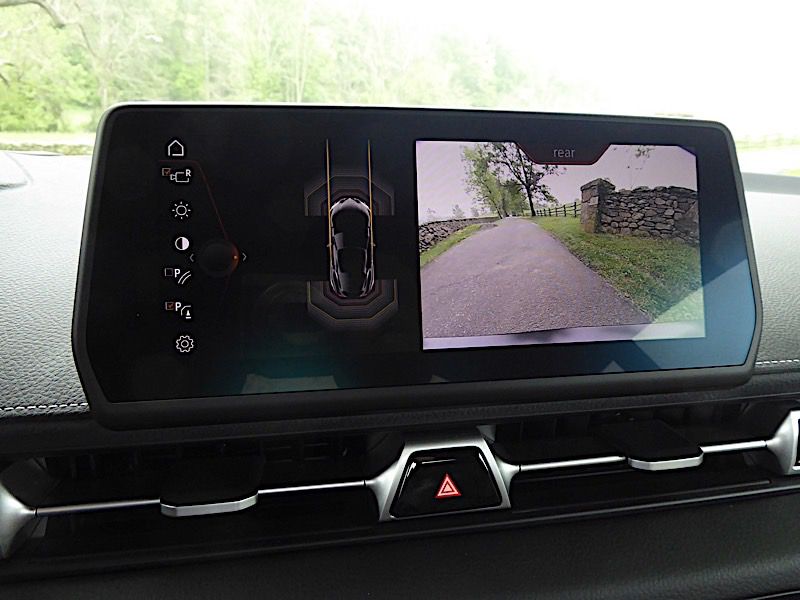
Photo by Ron Sessions
Dynamically Speaking
The Supra’s exemplary neutral handling balance comes via Toyota’s Gazoo Racing. The Gazoo crew tuned the suspension and selected the spring rates as well as the damping rates for the standard adaptive shocks. The car’s variable electric-assist steering tracks true and straight on fast stretches and helps rotate the car with precision in turns.
Low-profile 255/35R19 front and 275/35R19 rear Michelin Pilot Super Sport performance tires on 19-inch forged aluminum wheels provide excellent grip. The car’s large-diameter four-wheel disc brakes deliver crisp, confidence-building response, with Brembo rotors and calipers up front handling repeated heavy snubs with no fade. An electronic active differential gives flexible lockup during cornering, adjusting drive torque side to side. It acts much like a torque vectoring system, improving turn-in response while maximizing stability.
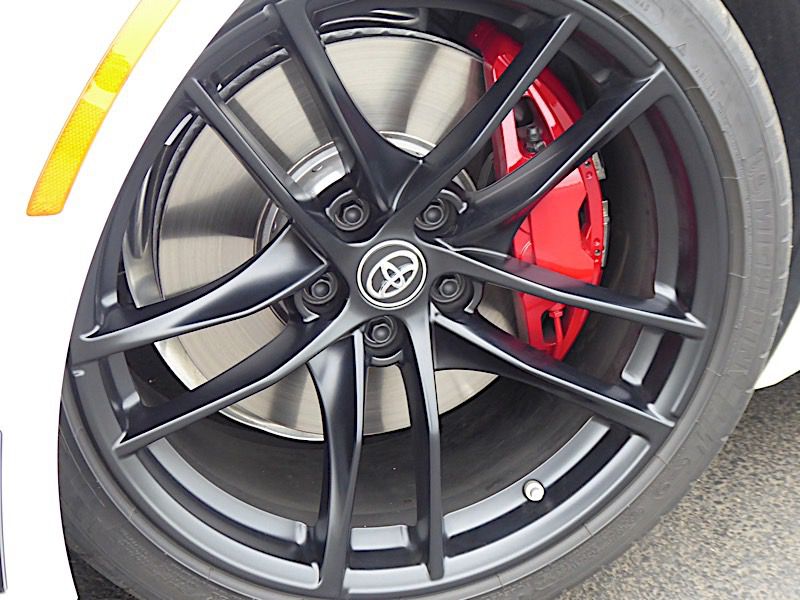
Photo by Ron Sessions
The Supra is back.
Some two decades and a whole bunch of "Fast and Furious" feature films after the last Supra arrived on these shores, a new smarter, faster, and better-connected version has arrived, courtesy of a joint effort with BMW.
Will it draw buyers out of their SUVs? Probably not. But it will be a good reason to pop into a Toyota showroom. As Toyota marketing group vice president Ed Laukes points out, “the Supra isn’t a car Toyota needed to make, it’s one they wanted to make.”
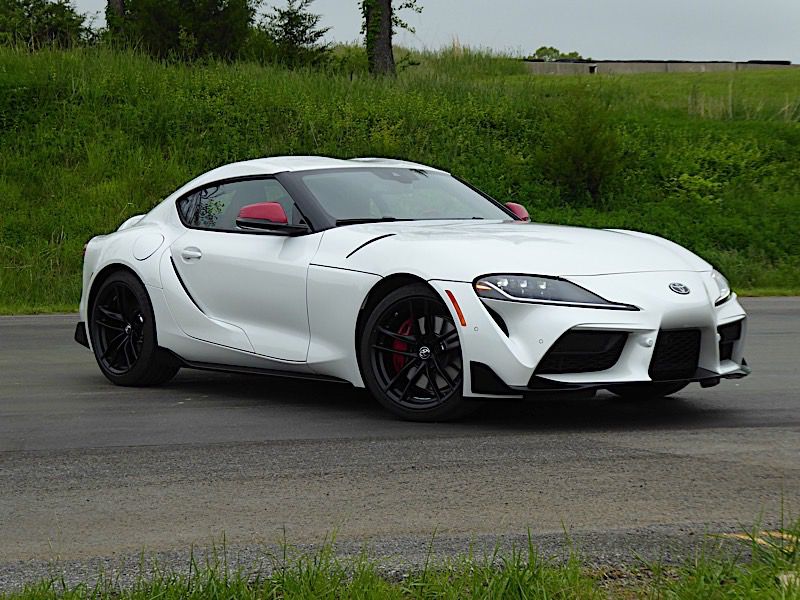
Photo by Ron Sessions